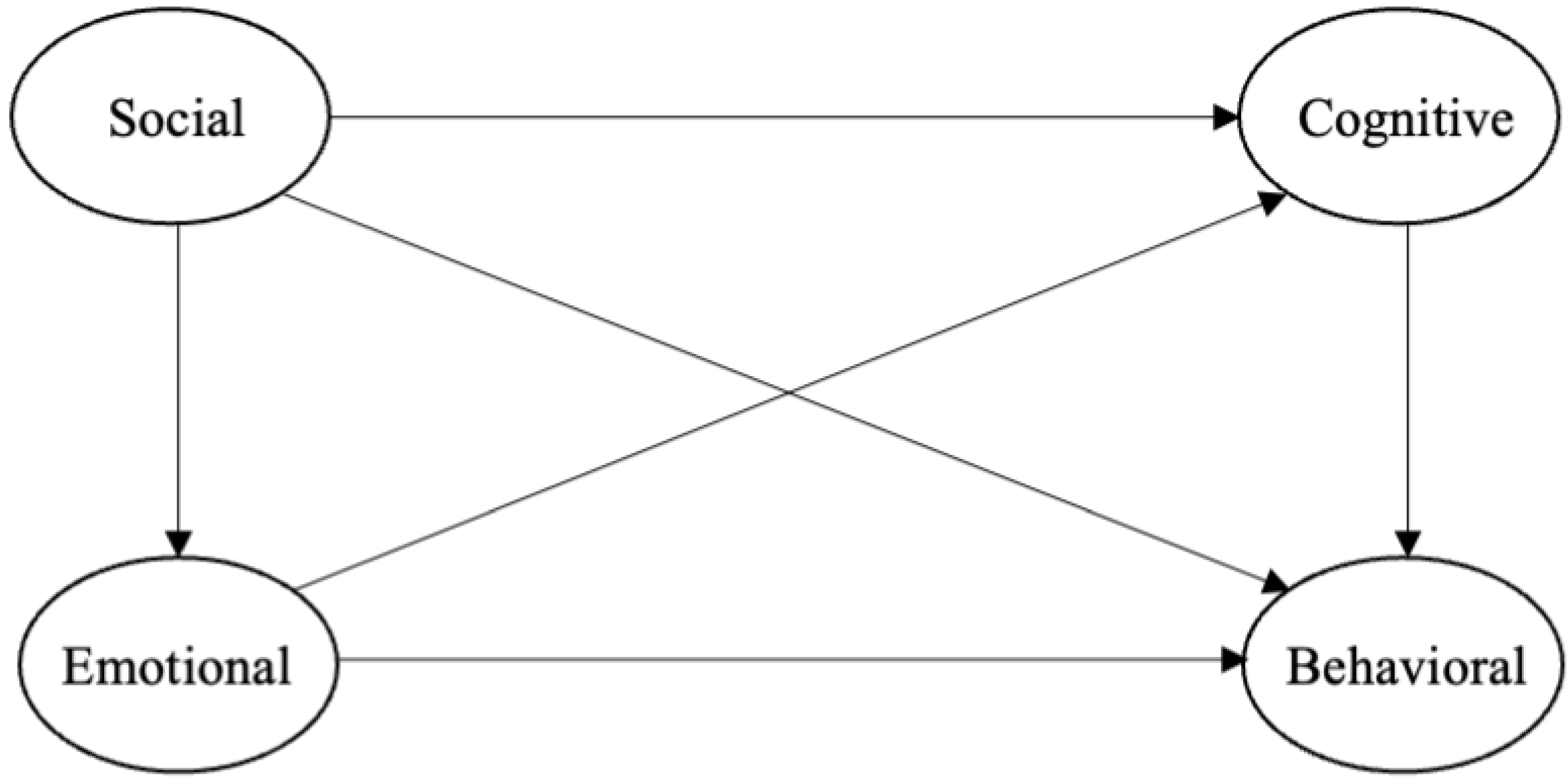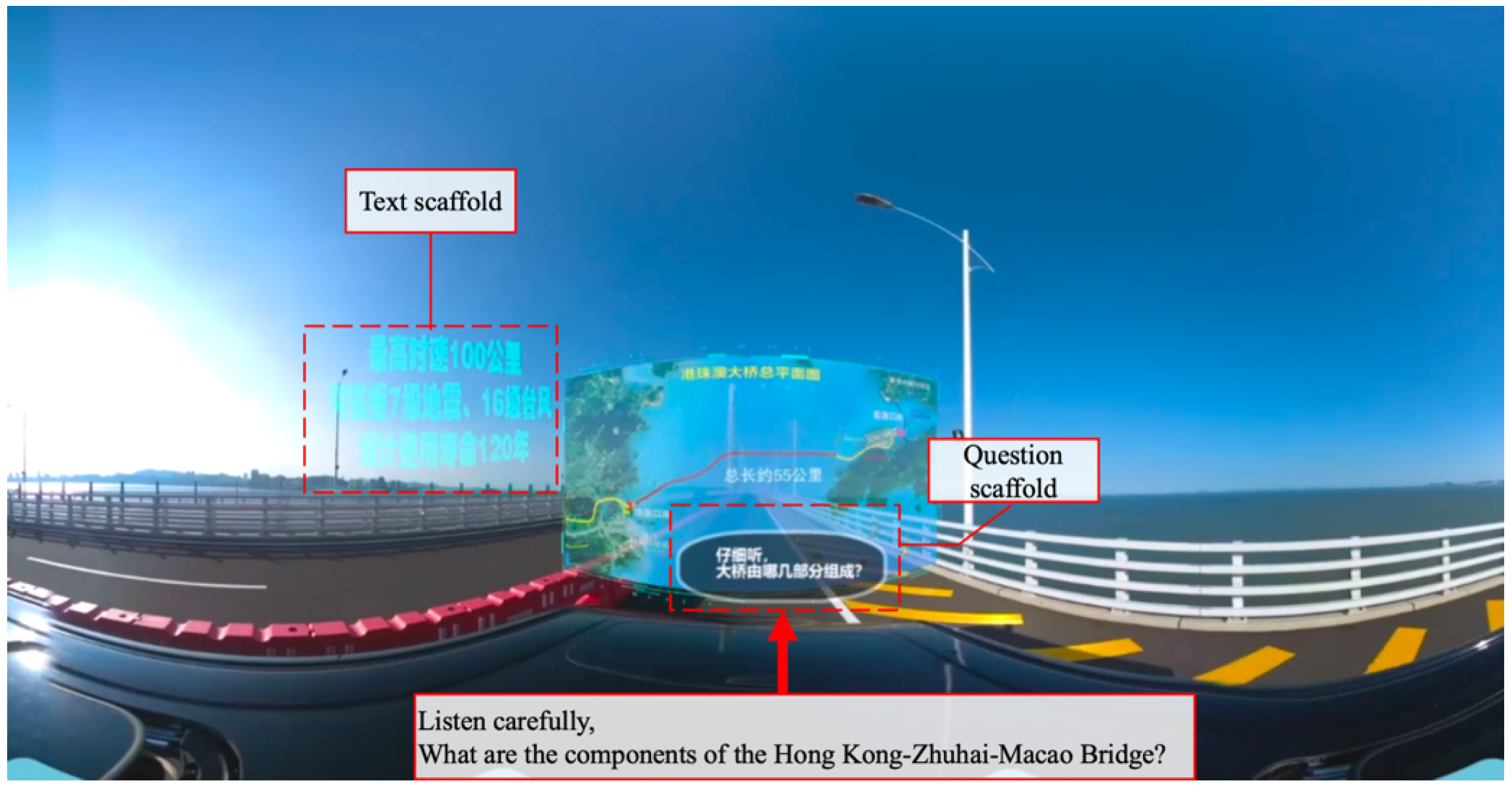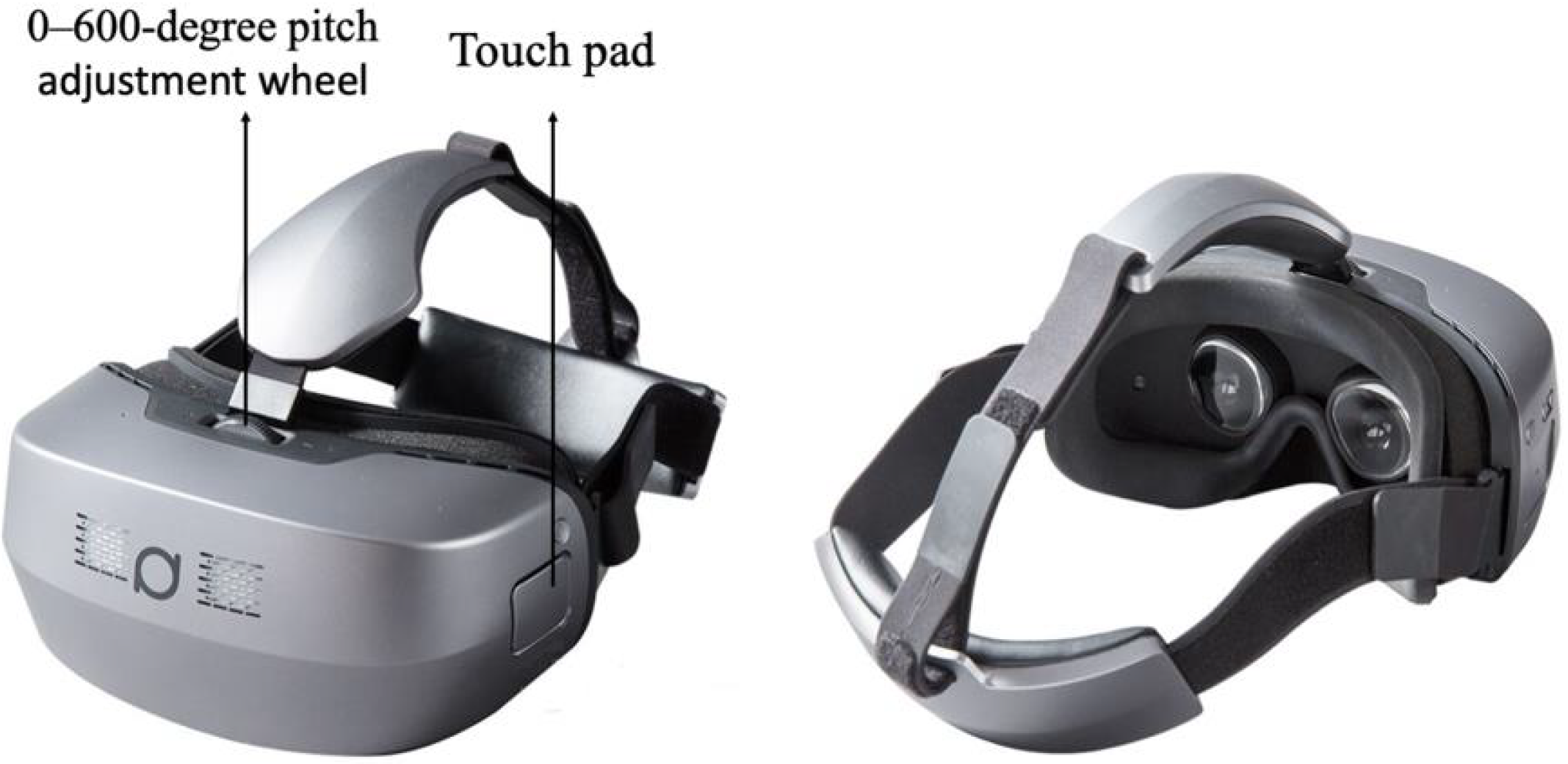Investigating Learners’ Engagement and Chinese Writing Learning Outcomes with Different Designs of SVVR-Based Activities
Abstract
:1. Introduction
2. Theoretical Background
2.1. Learning Engagement
2.2. Effects of SVVR-Based Learning on Learning Engagement
2.3. Effects of SVVR-Based Learning on Writing Learning
3. Experimental Design
3.1. Research Purpose and Research Questions
- To what extent does the level of writing learning engagement differ between the students who participated in the DL-SVVR and SL-SVVR?
- Are there any differences between the different subscales of engagement in the DL-SVVR and SL-SVVR groups?
- Are there any differences between the DL-SVVR and SL-SVVR groups in terms of writing learning outcomes?
3.2. Participants
3.3. DL-SVVR and SL-SVVR Writing Learning Activities
3.3.1. DL-SVVR and SL-SVVR Writing Learning Model
3.3.2. Development of Learning Material
3.3.3. Stages of SVVR-Based Writing Learning Activities
3.4. Experimental Procedure
3.5. Instruments
3.6. Student Interview Questions
3.7. Data Analysis
4. Results
4.1. Group Differences in the Students’ Engagement
4.2. Group Differences in the Students’ Writing Outcomes
4.3. Qualitative Analysis
- #1 said, “When I visited the Hong Kong-Zhuhai-Macao Bridge, I felt that the bridge was so grand and I felt like I was on the scene”.
- #2 said, “After the observation, I think there are many topics I can talk about with my classmates, such as the architectural history of the bridge, the length of the bridge and the shape of the bridge”.
- #12 said, “I hope to be able to use SVVR again in the next writing class. I think this writing class is so interesting so I hope to be able to take it a few more times! I even hope each writing class is like this. In this way, I don’t have to worry about the exam, I can recall these beautiful scenes very well”.
- #2 said, “This is the first time that I have taken a writing class in this mode. I think it is very interesting and helpful to improve my writing ability”.
- #4 said, “I often thought it was difficult to understand the scenes described in the text, and I could not flexibly use the paragraph structure in the text; therefore, the composition paragraphs that I wrote were very short and incoherent. Luckily, in the process of discussion with the teacher and my peers, I re-understood how good paragraphs in the text are described, and I will also try to use these paragraph structures”.
- #6 said “After observing these vivid underwater worlds, I found that I could more easily understand the meaning of the words in the text, and I could recall these beautiful words in my writing”.
- #5 said, “In the process of SS interaction, my classmates often have different perspectives with me. After communicating with them, I will gain a lot of inspiration, and these inspiring ideas can promote my imagination”.
- #12 said, “Compared with the previously-used learning approaches, I think the discussion and interaction with the teacher can improve my verbal capability”.
- #16 said, “I feel that in the process of interacting with the teacher, my learning initiative will be improved, and my expression ability can also be trained”.
- #18 said, “I really want to communicate and discuss with my classmates because I think they can bring me more inspiration for writing to improve my writing performance”.
5. Discussion
5.1. Analysis of the Group Differences in the Students’ Engagement
5.2. Analysis of the Group Differences in the Students’ Writing Outcomes
6. Conclusions
Author Contributions
Funding
Institutional Review Board Statement
Informed Consent Statement
Data Availability Statement
Conflicts of Interest
References
- Ye, X.; Liu, P.F.; Lee, X.Z.; Zhang, Y.Q.; Chiu, C.K. Classroom misbehavior management: An SVVR-based training system for preservice teachers. Interact. Learn. Environ. 2021, 29, 112–129. [Google Scholar] [CrossRef]
- Huang, H.; Hwang, G.J.; Chang, S.C. Facilitating decision making in authentic contexts: An SVVR-based experiential flipped learning approach for professional training. Interact. Learn. Environ. 2021, 1–17. [Google Scholar] [CrossRef]
- Wu, J.; Guo, R.; Wang, Z.; Zeng, R. Integrating spherical video-based virtual reality into elementary school students’ scientific inquiry instruction: Effects on their problem-solving performance. Interact. Learn. Environ. 2021, 29, 496–509. [Google Scholar] [CrossRef]
- Wu, W.L.; Hsu, Y.; Yang, Q.F.; Chen, J.J.; Jong, M.S.Y. Effects of the self-regulated strategy within the context of spherical video-based virtual reality on students’ learning performances in an art history class. Interact. Learn. Environ. 2021. [Google Scholar] [CrossRef]
- Chien, S.Y.; Hwang, G.J. A question, observation, and organisation-based SVVR approach to enhancing students’ presentation performance, classroom engagement, and technology acceptance in a cultural course. Br. J. Educ. Technol. 2022, 53, 229–247. [Google Scholar] [CrossRef]
- Chien, S.Y.; Hwang, G.J.; Jong, M.S.Y. Effects of peer assessment within the context of spherical video-based virtual reality on EFL students’ English-speaking performance and learning perceptions. Comput. Educ. 2020, 146, 103751. [Google Scholar] [CrossRef]
- Huang, H.L.; Hwang, G.J.; Chang, C.Y. Learning to be a writer: A spherical video-based virtual reality approach to supporting descriptive article writing in high school Chinese courses. Br. J. Educ. Technol. 2020, 50, 2251–2270. [Google Scholar] [CrossRef]
- Yang, G.; Chen, Y.T.; Zheng, X.L.; Hwang, G.J. From experiencing to expressing: A virtual reality approach to facilitating pupils’ descriptive paper writing performance and learning behavior engagement. Br. J. Educ. Technol. 2021, 52, 807–823. [Google Scholar] [CrossRef]
- Trowler, V. Student engagement literature review. High. Educ. Acad. 2010, 11, 1–15. [Google Scholar]
- Sun, F.R.; Pan, L.F.; Wan, R.G.; Li, H.; Wu, S.J. Detecting the effect of student engagement in an SVVR school-based course on higher level competence development in elementary schools by SEM. Interact. Learn. Environ. 2021, 29, 3–16. [Google Scholar] [CrossRef]
- Skinner, E.A.; Belmont, M.J. Motivation in the classroom: Reciprocal effects of teacher behavior and student engagement across the school year. J. Educ. Psychol. 1993, 85, 571–581. [Google Scholar] [CrossRef]
- Fredricks, J.A.; Blumenfeld, P.C.; Paris, A.H. School engagement: Potential of the concept, state of the evidence. Rev. Educ. Res. 2004, 74, 59–109. [Google Scholar] [CrossRef] [Green Version]
- Brophy, J. Motivating Students to Learn, 2nd ed.; Routledge: London, UK, 2004. [Google Scholar]
- Chai, C.S.; Deng, F.; Tsai, P.S.; Koh, J.H.L.; Tsai, C.C. Assessing multidimensional students’ perceptions of twenty-first-century learning practices. Asia Pac. Educ. Rev. 2015, 16, 389–398. [Google Scholar] [CrossRef]
- Christenson, S.L.; Reschly, A.L.; Wylie, C. Handbook of Research on Student Engagement; Springer: New York, NY, USA, 2012. [Google Scholar]
- Wang, M.T.; Fredricks, J.A.; Ye, F.; Hofkens, T.L.; Linn, J.S. The math and science engagement scales: Scale development, validation, and psychometric properties. Learn. Instr. 2016, 43, 16–26. [Google Scholar] [CrossRef] [Green Version]
- Xu, B.; Chen, N.S.; Chen, G. Effects of teacher role on student engagement in WeChat-Based online discussion learning. Comput. Educ. 2020, 157, 103956. [Google Scholar] [CrossRef]
- Li, Y.; Lerner, J.V.; Lerner, R.M. Personal and ecological assets and academic competence in early adolescence: The mediating role of school engagement. J. Youth Adolesc. 2010, 39, 801–815. [Google Scholar] [CrossRef]
- Jelas, Z.M.; Azman, N.; Zulnaidi, H.; Ahmad, N.A. Learning support and academic achievement among Malaysian adolescents: The mediating role of student engagement. Learn. Environ. Res. 2016, 19, 221–240. [Google Scholar] [CrossRef]
- Zhang, S.; Liu, Q. Investigating the relationships among teachers’ motivational beliefs, motivational regulation, and their learning engagement in online professional learning communities. Comput. Educ. 2019, 134, 145–155. [Google Scholar] [CrossRef]
- Drigas, A.; Ioannidou, R.E.; Kokkalia, G.; Lytras, M.D. ICTs, mobile learning and social media to enhance learning for attention difficulties. J. Univ. Comput. Sci. 2014, 20, 1499–1510. [Google Scholar]
- Chen, M.; Chai, C.S.; Jong, M.S.Y.; Jiang, M.Y.C. Teachers’ conceptions of teaching Chinese descriptive composition with interactive spherical video-based virtual reality. Front. Psychol. 2021, 12, 150. [Google Scholar] [CrossRef]
- Lin, H.C.S.; Yu, S.J.; Sun, J.C.Y.; Jong, M.S.Y. Engaging university students in a library guide through wearable spherical video-based virtual reality: Effects on situational interest and cognitive load. Interact. Learn. Environ. 2021, 29, 1272–1287. [Google Scholar] [CrossRef]
- Li, Y.; Lerner, R.M. Interrelations of behavioral, emotional, and cognitive school engagement in high school students. J. Youth Adolesc. 2013, 42, 20–32. [Google Scholar] [CrossRef] [PubMed]
- Lee, S.W.Y.; Shih, M.; Liang, J.C.; Tseng, Y.C. Investigating learners’ engagement and science learning outcomes in different designs of participatory simulated games. Br. J. Educ. Technol. 2021, 52, 1197–1214. [Google Scholar] [CrossRef]
- Mann, S. Scene-setting: Writing biography in Chinese history. Am. Hist. Rev. 2009, 114, 631–639. [Google Scholar] [CrossRef]
- Hwang, G.J.; Wang, S.Y. Single loop or double loop learning: English vocabulary learning performance and behavior of students in situated computer games with different guiding strategies. Comput. Educ. 2016, 102, 188–201. [Google Scholar] [CrossRef]
- Johnson-Glenberg, M.C. The Necessary Nine: Design Principles for Embodied VR and Active Stem Education. In Learning in a Digital World; Smart Computing and Intelligence; Díaz, P., Ioannou, A., Bhagat, K., Spector, J., Eds.; Springer: Singapore, 2019. [Google Scholar]
- Makransky, G.; Borre-Gude, S.; Mayer, R.E. Motivational and cognitive benefits of training in immersive virtual reality based on multiple assessments. J. Comput. Assist. Learn. 2019, 35, 691–707. [Google Scholar] [CrossRef]
- Baceviciute, S.; Terkildsen, T.; Makransky, G. Remediating learning from non-immersive to immersive media: Using EEG to investigate the effects of environmental embeddedness on reading in Virtual Reality. Comput. Educ. 2021, 164, 104122. [Google Scholar] [CrossRef]
- Piaget, J.; Inhelder, B. The Growth of Logical Thinking from Childhood to Adolescence: An Essay on the Construction of Formal Operational Structures; Routledge: London, UK, 2013. [Google Scholar]
- Kolb, D.A. Experiential Learning: Experience as the Source of Learning and Development; FT Press: Upper Saddle River, NJ, USA, 2014. [Google Scholar]
- Lo, J.; Hyland, F. Enhancing students’ engagement and motivation in writing: The case of primary students in Hong Kong. J. Second. Lang. Writ. 2007, 16, 219–237. [Google Scholar] [CrossRef]
- Theelen, H.; van den Beemt, A.; den Brok, P. Developing preservice teachers’ interpersonal knowledge with 360-degree videos in teacher education. Teach. Teach. Educ. 2020, 89, 102992. [Google Scholar] [CrossRef]
- Chang, S.C.; Hsu, T.C.; Kuo, W.C.; Jong, M.S.Y. Effects of applying a VR-based two-tier test strategy to promote elementary students’ learning performance in a Geology class. Br. J. Educ. Technol. 2020, 51, 148–165. [Google Scholar] [CrossRef]
- McGraw, K.O.; Wong, S.P. Forming inferences about some intraclass correlation coefficients. Psychol. Methods 1996, 1, 30–46. [Google Scholar] [CrossRef]
- Goggins, S.; Xing, W. Building models explaining student participation behavior in asynchronous online discussion. Comput. Educ. 2016, 94, 241–251. [Google Scholar] [CrossRef]
- Chin, W.W.; Marcolin, B.L.; Newsted, P.R. A partial least squares latent variable modeling approach for measuring interaction effects: Results from a Monte Carlo simulation study and an electronic-mail emotion/adoption study. Inf. Syst. Res. 2003, 14, 189–217. [Google Scholar] [CrossRef] [Green Version]
- Chin, W.W.; Marcolin, B.L.; Newsted, P.R. The partial least squares approach to structural equation modeling. Mod. Methods Bus. Res. 1998, 295, 295–336. [Google Scholar]
- Nunnally, J.C. An Overview of Psychological Measurement. In Clinical Diagnosis of Mental Disorders; Wolman, B.B., Ed.; Springer: Boston, MA, USA, 1978. [Google Scholar]
- Hair, J.F., Jr.; Sarstedt, M.; Ringle, C.M.; Gudergan, S.P. Advanced Issues in Partial Least Squares Structural Equation Modeling; SAGE Publications: Newcastle upon Tyne, UK, 2017. [Google Scholar]
- Charmaz, K. Constructing Grounded Theory: A Practical Guide Through Qualitative Analysis; SAGE Publications: Newcastle upon Tyne, UK, 2006. [Google Scholar]
- Nguyen, T.D.; Cannata, M.; Miller, J. Understanding student behavioral engagement: Importance of student interaction with peers and teachers. J. Educ. Res. 2018, 111, 163–174. [Google Scholar] [CrossRef]
- Pan, W. English-writing teaching of vocational colleges in big data era. In Proceedings of the 2nd International Conference on Education Science and Social Development, Changsha, China, 20–21 July 2019; pp. 168–171. [Google Scholar]







| Learning Flow | Description | Learning Activities |
|---|---|---|
| Lead in | Motivation stimulaion | Teacher:
|
| Questioning | Provoke thought | Teacher:
|
| Observing | Concrete experience | Teacher:
|
| Questioning | Abstract conceptualization | DL-SVVR group:
|
| Observing | Reflective observation | Teacher:
|
| Questioning | Abstract extension | DL-SVVR group:
|
| Producing | Evaluation, revision and writing | Teacher:
|
| Engagement Variables | CR | AVE | Cronbach’s Alpha | |||
|---|---|---|---|---|---|---|
| DL-SVVR | SL-SVVR | DL-SVVR | SL-SVVR | DL-SVVR | SL-SVVR | |
| Emotional (E) | 0.79 | 0.90 | 0.51 | 0.69 | 0.63 | 0.85 |
| Social (S) | 0.90 | 0.91 | 0.60 | 0.63 | 0.87 | 0.88 |
| Behavioral (B) | 0.75 | 0.74 | 0.51 | 0.50 | 0.60 | 0.61 |
| Cognitive (C) | 0.81 | 0.82 | 0.53 | 0.53 | 0.69 | 0.72 |
| Before Treatment | After Treatment | Univariate ANCOVA | |||||||
|---|---|---|---|---|---|---|---|---|---|
| Variance | Group | Mean | SD | Mean | SD | Mean (Adjusted) | Standard Error | F | p |
| Emotional | SL-SVVR | 16.67 | 3.068 | 17.98 | 2.304 | 18.03 | 0.306 | 2.238 | 0.139 |
| DL-SVVR | 17.13 | 2.095 | 17.42 | 1.840 | 17.36 | 0.326 | |||
| Social | SL-SVVR | 22.44 | 5.170 | 23.36 | 3.899 | 23.55 | 0.563 | 0.269 | 0.606 |
| DL-SVVR | 23.89 | 4.367 | 24.18 | 3.850 | 23.98 | 0.599 | |||
| Behavioral | SL-SVVR | 16.30 | 2.263 | 17.09 | 1.674 | 17.22 | 0.242 | 3.9900 * | 0.049 |
| DL-SVVR | 17.29 | 1.814 | 18.08 | 1.634 | 17.94 | 0.258 | |||
| Cognitive | SL-SVVR | 16.02 | 2.099 | 16.95 | 2.267 | 17.10 | 0.310 | 0.056 | 0.814 |
| DL-SVVR | 16.82 | 1.784 | 17.16 | 2.007 | 16.99 | 0.330 | |||
| Before Treatment | After Treatment | Univariate ANCOVA | |||||||
|---|---|---|---|---|---|---|---|---|---|
| Variance | Group | Mean | SD | Mean | SD | Mean (Adjusted) | Standard Error | F | p |
| Overall writing means | SL-SVVR | 78.914 | 5.732 | 78.869 | 7.229 | 78.634 | 1.259 | 8.987 ** | 0.004 |
| DL-SVVR | 77.694 | 6.181 | 83.921 | 9.985 | 84.194 | 1.355 | |||
Publisher’s Note: MDPI stays neutral with regard to jurisdictional claims in published maps and institutional affiliations. |
© 2022 by the authors. Licensee MDPI, Basel, Switzerland. This article is an open access article distributed under the terms and conditions of the Creative Commons Attribution (CC BY) license (https://creativecommons.org/licenses/by/4.0/).
Share and Cite
Li, M.; Chen, Y.; Zhang, L.; Wu, X.; Huang, C. Investigating Learners’ Engagement and Chinese Writing Learning Outcomes with Different Designs of SVVR-Based Activities. Sustainability 2022, 14, 4767. https://doi.org/10.3390/su14084767
Li M, Chen Y, Zhang L, Wu X, Huang C. Investigating Learners’ Engagement and Chinese Writing Learning Outcomes with Different Designs of SVVR-Based Activities. Sustainability. 2022; 14(8):4767. https://doi.org/10.3390/su14084767
Chicago/Turabian StyleLi, Ming, Yuting Chen, Linjie Zhang, Xuemei Wu, and Changqin Huang. 2022. "Investigating Learners’ Engagement and Chinese Writing Learning Outcomes with Different Designs of SVVR-Based Activities" Sustainability 14, no. 8: 4767. https://doi.org/10.3390/su14084767
APA StyleLi, M., Chen, Y., Zhang, L., Wu, X., & Huang, C. (2022). Investigating Learners’ Engagement and Chinese Writing Learning Outcomes with Different Designs of SVVR-Based Activities. Sustainability, 14(8), 4767. https://doi.org/10.3390/su14084767






